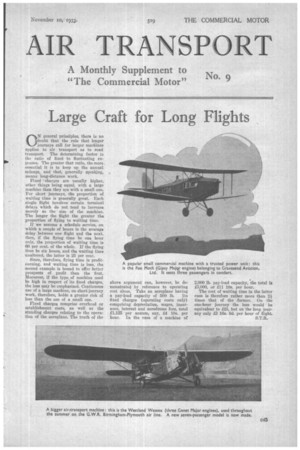Large Craft for Lon Flights
Page 75

If you've noticed an error in this article please click here to report it so we can fix it.
ON general principles, there is no doubt that the rule that longer journeys call for larger machines applies to air transport as to road
transport. The determining factor is the ratio of fixed to fluctuating ex penses. The greater that ratio, the more essential it is to keep up the annual mileage, and that, generally speaking, means long-distance work.
Fixed • charges are usually higher, other things being equal, with a large machine than they are with a small one.
For short journeys, the proportion of waiting time is generally great. Each single flight involves certain terminal delays which do not tend to increase merely as the also of the machine. The longer the flight the greater the proportion of flying to waiting time.
If we assume a schedule service, on .which a couple of hours is the average delay between one flight and the next, then, if the flying time be one hour only, the proportion of waiting time is 66 per cent. of the whole. If the flying time be six hours, and the waiting time unaltered, the latter is 25 per cent.
Since, therefore, flying time is profitearning, and waiting time is loss, the second example is bound to offer better prospects of profit than the first. Moreover, if the type of machine used
be high in respect of its fixed charges, the loss may be emphasized. Continuous use of a large machine, on short-journey work, therefore, holds a greater risk of loss than the use of a small one.
Fixed charges comprise overhead or establishment costs, as well as the standing charges relating to the operation of the aeroplane. The truth of the above argument can, however, be demonstrated by reference to operating cost alone. Take an aeroplane having
a pay-load capacity of 500 lb. Its fixed charges (operating costs only) comprising depreciation, wages, insurance, interest and aerodrome fees, total £1,125 per annum, say, £4 10s. per hour. In the case of a machine of 2,000 lb. pay-load capacity, the total is £3,000, OT £11 10S. per hour.
The cost of waiting time in the latter case is therefore rather more than 2i times that of the former., On the one-hour journey the loss would be equivalent to £23, but on the long journey only 12 16s. 8d. per hour of flight.
S.T.R.




























































































































